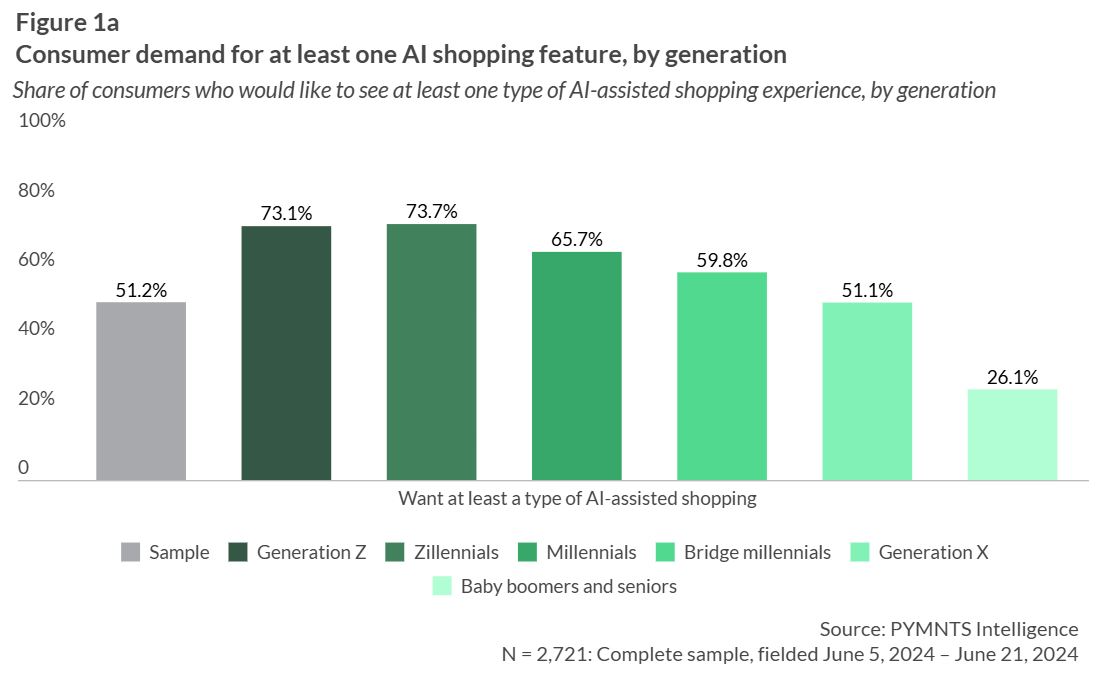More Than Half of Consumers Want Smarter Shopping Experiences
Consumer expectations around shopping are changing, with higher demand for personalized, artificial intelligence (AI)-driven experiences that offer convenience, customization and efficiency.
A PYMNTS Intelligence report, “Getting to Know You: How AI Is Shaping the Future of Shopping,” explores how retailers are responding by integrating AI into every stage of the customer journey, from personalized recommendations to virtual try-ons and voice commerce. This evolution goes beyond adopting new technologies; it’s about developing strategies that build customer loyalty and drive sales growth.
The Growing Demand for AI-Powered Shopping
The demand for AI-driven shopping experiences is growing, with 51% of consumers expressing interest in AI features. This demand is strongest among higher-income and younger shoppers. Among those earning more than $100,000 annually, 59% are interested in AI-powered retail, compared to just 40% of consumers making less than $50,000. Additionally, younger generations are leading the charge, with 73% of Gen Z and 74% of zillennials seeking AI-enhanced shopping journeys.
This growing interest is driving retailers to integrate AI into their offerings. Companies like Walmart and Best Buy are enhancing search functions and adding AI-powered features, such as smarter tracking for online purchases. As these technologies continue to evolve, AI is becoming an expectation rather than a novelty for consumers.
Personalization Is the Key to EngagementPersonalized shopping experiences are the most desired AI feature, with 25% of consumers wanting tailored promotions or deals. This demand is especially strong among younger shoppers, with 33% of Gen Z and millennials seeking personalized offers. Retailers are responding by focusing on personalization — Kroger, for example, uses tailored promotions to boost loyalty, while Macy’s invests in targeted deals to improve customer satisfaction.
In addition to personalized offers, 18% of consumers want AI to enable product customization based on their preferences or budget, with 29% of Gen Z shoppers showing particular interest. These AI-driven innovations not only enhance the shopping experience but also strengthen customer loyalty by catering to individual needs, encouraging repeat business.
The Rise of Voice AI and Its Growing PopularityVoice AI is becoming a key part of the retail experience. According to the report, 27% of consumers have used voice prompts for shopping tasks in the past year, with 42% of Gen Z and nearly one-third of high-income shoppers (those with annual incomes of $100,000 or more) engaging with voice assistants for shopping.
Despite this growth, voice commerce is still evolving. Only 6.9% of consumers have used voice AI to complete an entire retail journey, from browsing to payment. While voice adoption is rising, most consumers still rely on other devices alongside voice commands. As retailers continue to integrate voice AI with other technologies, its potential to enhance and personalize the shopping experience is clear. Most consumers still combine voice with other devices to complete purchases, signaling that the ceiling for voice technology growth is high.
As the retail industry becomes tech-driven, companies embracing AI stand to lead the way in shaping the future of shopping.
The post More Than Half of Consumers Want Smarter Shopping Experiences appeared first on PYMNTS.com.
